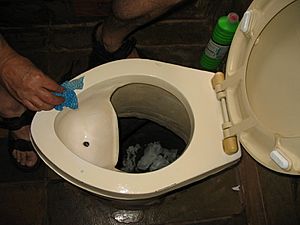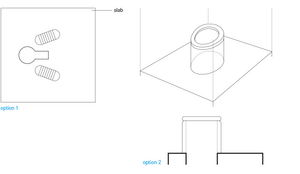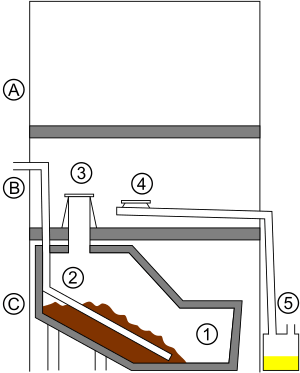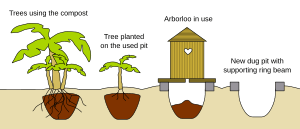Dry toilet facts for kids
A dry toilet is a special kind of toilet that doesn't use water to flush away human waste. This is very different from the flush toilets you might have at home! Dry toilets can be designed for sitting or for squatting. Sometimes, the urine (pee) and feces (poop) mix together, and sometimes they are kept separate.
There are many types of dry toilets. Some common ones include: composting toilets, urine-diverting dry toilets, Arborloos, container-based toilets, bucket toilets, pit latrines, incinerating toilets, and freezing toilets.
Contents
Types of Dry Toilets
All dry toilets work without flush water. They also don't need connections to sewers or large septic tanks.
- Composting toilet: These toilets usually mix feces, urine, and sometimes even kitchen scraps together. The waste then breaks down into a soil-like material.
- Urine-diverting dry toilet (UDDT): With these, urine is kept separate from feces. The urine can be used as a great fertilizer for plants. Keeping the urine separate also helps the feces stay drier.
- Arborloo: This is like a small pit latrine. The pit is smaller, and the toilet building is light. You can move the building to a new pit when the old one is full. Then, a tree is planted on the old pit, using the waste as nutrients.
- Container-based toilet: In these toilets, waste goes into special containers. These containers are then taken to places where the waste is processed safely.
- Bucket toilet: This is simply a pail or bucket. Some bucket toilets also keep urine separate and cover the feces with dry material like sawdust.
- Pit latrine: This is a basic hole in the ground used for waste.
- Incinerating toilet: These toilets burn the waste.
- Freezing toilet: These toilets freeze the waste.
- Other new types of dry toilets are being developed. Some even get funding from the Bill and Melinda Gates Foundation.
Why Use Dry Toilets?
There are four main reasons why people choose to use dry toilets:
- Save water: They don't use water for flushing, which saves a lot of water and money.
- Prevent water pollution: Since no water is used, they help stop dirty water from polluting rivers and lakes.
- Recycle nutrients: After being treated and stored to kill germs, the waste can be used as nutrients for plants in farming. This helps recycle valuable resources.
- Adapt to difficult places: Dry toilets are great for places where sewers and wastewater treatment systems are not possible. This can be due to rocky land, spread-out houses, or high costs.
Dry toilets can look very nice and are used in many developed countries. For example, in Sweden, Finland, and Norway, you often find them at summer houses and national parks. They are also common in developing countries where flush toilets are not an option or are not wanted.

Challenges with Dry Toilets
Some people strongly believe that dry toilets are the best way to handle human waste. Others think they can't be used everywhere. Some people simply don't want to change their habits.
When managed well, dry toilets can:
- Reduce how much water we use.
- Lower pollution.
- Help get valuable nutrients back for farming.
- Get rid of diseases and chemicals safely.
It has been hard to set up and manage many dry toilets in big cities. For example, this was a challenge in the Erdos Eco-City in China. The designs need to be improved. We also need to be very careful when building and managing them. People who use them also need to learn about their benefits and how to use them correctly.
History of Dry Toilets
For a long time, nearly all toilets were dry toilets. People valued human waste because it could be used to help plants grow. This was true until flush toilets were invented.
Dry Toilets in Britain
In Britain, dry toilets were still used in some areas, even in cities, until the 1940s. It seems that the waste was often emptied directly onto gardens. There, it was used as fertilizer. Sewer systems did not come to some rural parts of Britain until the 1950s or even later.
Dry Toilets in Australia
Brisbane, Australia, did not have many sewers until the early 1970s. Many suburbs had dry toilets, which they called "dunnies," behind each house.
Images for kids
-
Historical German dry toilet with a mechanism to add peat moss to cover feces
Related Pages
- Sanitation
- Waste management
- Dry toilet publications in the library of the Sustainable Sanitation Alliance











